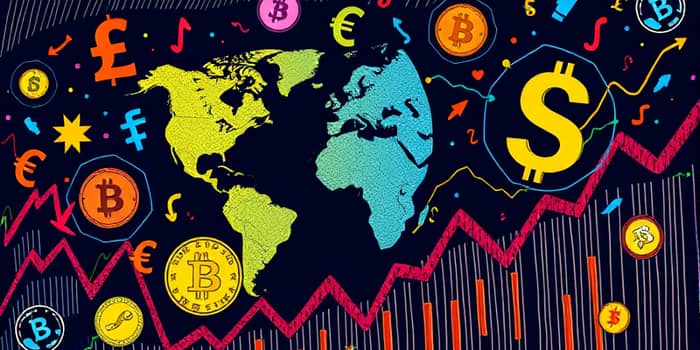
The global foreign exchange landscape is experiencing an unprecedented level of divergence as major central banks pursue contrasting monetary policies. This broad gap in interest rate paths has fueled one of the most dynamic periods of market swings in recent memory, reshaping currency trends and investment flows across regions. Traders, policymakers, and investors alike must now navigate a complex environment of evolving yields, fiscal interactions, and shifting capital allocations.
Understanding the drivers behind this surge in volatility is essential for developing effective strategies that capture opportunities and safeguard against risks. In this article, we explore recent data for 2025, examine the mechanisms that amplify exchange rate movements, and outline practical responses to thrive in this challenging market context.
At its core, interest rate divergence occurs when major central banks take different approaches to monetary policy. While the U.S. Federal Reserve has maintained a more hawkish stance to temper persistent inflationary pressures, the European Central Bank opted to cut its deposit facility rate by 25 basis points to 2.00% in June 2025 in response to sluggish growth and subpar inflation. Concurrently, the Bank of Japan is considering a modest hike after years of negative rates, and the Reserve Bank of Australia waits on domestic labor market data.
This split in policy directions exerts significant pressure on capital flows, triggering swift shifts in capital flows as investors chase higher yields. When the yield gap between the U.S. 10-year Treasury and comparable bonds in Europe or Japan widens to its highest level since 1994, as it has in 2025, even small changes in rate outlooks can lead to explosive movements in spot and derivative markets.
The widening gap between policy rates is already manifesting in extraordinary levels of currency volatility. Forex traders are increasingly engaged in carry trades, borrowing low-rate currencies such as the Japanese yen to invest in higher-yield assets like the U.S. dollar, thereby amplifying exchange rate movements. Spot markets have seen rapid, large-scale swings as pricing adjusts to reflect new rate differentials.
Key market highlights of early 2025 include:
These shifts underscore that in a world of heightened currency market swings, timing and precision are critical. Investors who reacted early to changes in swap rates and futures contracts have captured outsized returns, while those who remained static suffered steep losses.
The table below highlights year-to-date currency rate changes for major pairs, illuminating the scope of market adjustments.
Several intertwined factors are fanning the flames of currency volatility. First, the divergence in economic growth trajectories sees the U.S. posting forecasts of 2.7% growth for 2024, while other developed markets average just 1.7%. This imbalance encourages capital flows toward stronger fundamentals.
In particular, emerging markets facing rate mismatches often resort to emergency rate hikes or currency interventions, which can both stabilize exchange rates and stoke fears of domestic credit stress. These policy responses further amplify global volatility through feedback loops in cross-border asset allocations.
In this environment, a proactive stance can help stakeholders both mitigate risks and capitalize on market dislocations. Investors should diversify across assets and geographies while paying close attention to central bank communications that might signal pivot points.
Policymakers and central banks, meanwhile, need to consider the spillovers of their actions on global financial conditions. Coordinated fiscal measures or transparent forward guidance may help smooth abrupt capital swings. For example, targeted government spending in Europe to support infrastructure can counterbalance monetary easing, helping to stabilize the euro and promote balanced growth.
Looking ahead, market pricing suggests that the Fed may implement only a 44 basis point cut through 2025, while the ECB is expected to ease by over 110 basis points and the Bank of Japan could steadily unwind negative rates. These projections imply that divergence will persist, maintaining pressure on exchange rates and volatility indices.
Key factors to watch include inflation trajectories in major economies, which will dictate central bank pivots; geopolitical developments that could reshape trade flows; and emerging market debt vulnerabilities, especially in countries with fixed or heavily managed exchange rates.
By staying informed, agile, and disciplined, market participants can harness the opportunities that arise from volatility rather than be overwhelmed by it. Successful navigation of this period will depend on continuous analysis, decisive execution, and resilient frameworks.
As we navigate this period of unprecedented level of divergence, the ability to analyze data, adapt to shifting policy signals, and execute with discipline will define success for traders, investors, and central bankers alike. Although the road ahead may be volatile, it offers significant potential rewards for those prepared to act.
Ultimately, navigating this evolving landscape demands a mindset that embraces change. Market participants who remain too rooted in previous cycles risk missing critical inflection points. By incorporating real-time analytics, maintaining diversified portfolios, and engaging in scenario planning, one can transform market volatility into a catalyst for growth rather than an obstacle. Embracing a forward-looking approach will be vital as we chart the next phase of global monetary coordination or divergence.
References













